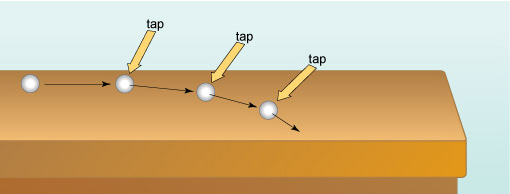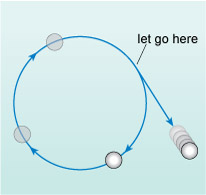3 Orbits and gravity
An understanding of orbital motion is fundamental to astronomy. It is crucial in the design of space missions and it enables astronomers to deduce the existence of planets associated with other stars. Stars can orbit one another and they also move in orbit around the centre of a galaxy. This section introduces some key ideas about orbital motion.
People sometimes wonder what keeps the Moon in orbit and stops it crashing to the Earth. This is a perfectly reasonable question to ask. If you lift an object above the Earth's surface and let it go, it falls to the ground, pulled down by the force of gravity. Why doesn't this happen to the Moon? Indeed, why don't the Earth and other planets fall into the Sun? To answer that question, and to see the role that gravity plays in the story, first requires an examination of circular motion.
If you set an object in motion it will move in a straight line, unless there is something pushing or pulling it into a curved path. To keep an object moving in a circular path, it needs constantly to be nudged sideways - there needs to be some force (that is, a push or a pull) directed towards the centre of the circle. The technical name for a force directed towards the centre of a circle is a centripetal force (centripetal means 'centre-seeking'). You can demonstrate this for yourself in the next activity.
Activity 1 Creating circular motion
For this activity you will need a table-tennis ball or large marble (or a similar smooth, smallish ball), a smooth table-top or floor, and about 1 metre of string (or wool) attached to a cork or a lump of plasticine (or other object of similar size and weight that can easily be fixed to your string). The second part of the activity (whirling the cork) needs to be done somewhere well away from people or objects that might be hit by a flying cork, ideally outdoors. Do not use a heavy object in this part of the activity.
First, roll the table-tennis ball (without spinning it) along the smooth surface. Note that it moves in a straight line.
Next, try to make it follow a curved path (again, without spinning it). You will find that, left to itself, it always follows a straight line. To get a curved path, you need to keep nudging it sideways, as shown in Figure 4. If you could exert a steady force rather than a series of taps, you could make the ball move in a smooth curve because you would be supplying the necessary centripetal force.

One way to supply a steady centripetal force is to pull on a piece of string attached to the moving object. Try whirling your cork or plasticine in a horizontal circle - you will feel that you need to keep pulling on the string as you do so.
Finally, let go of the string while whirling the cork and note the way it moves. You should be able to see that it continues to move in the direction it was heading at the time of release, as shown in Figure 5.

The need for a centripetal force applies to all cases of circular motion. In the example of the whirling cork, the force providing the inward pull is easy to see, but sometimes it is less so. For example, when a car is rounding a bend, the thrust of the engine and the grip of the tyres on the road combine to produce the necessary centripetal force.
What about the Moon? The Moon orbits the Earth in a (nearly) circular orbit.
What must be providing the centripetal force for the Moon's orbit?
The force of gravity acting between the Earth and the Moon keeps the Moon moving in its nearly circular path.
What would happen to the Moon if gravity suddenly stopped acting?
The Moon would drift off into space since there would be nothing to hold it in orbit around the Earth.
Gravity is familiar to us as the force that pulls objects towards the Earth, but our planet is not special in exerting this force. In fact, gravity acts between all objects. The strength of this attractive force increases in proportion to the product of the masses of the two bodies and decreases in proportion to the square of the distance between the centres of the two bodies. Thus, the more massive the bodies and the closer they are, the stronger the force. Just as the Earth and the Moon are attracted towards each other by gravity, so too are all bodies. (Example: if you increase the distance by a factor of 3, the force of gravity decreases by a factor of three squared, written as 32 = 3 by 3 = 9.) Even you and your cup of coffee are attracted to one another by gravity, but the force between small objects is so weak that it is normally unnoticed. We are usually only aware of gravity when at least one object is almost planet-sized.
If the Moon was simply suspended above the Earth and dropped, rather than moving in orbit, it would indeed move directly towards the Earth, pulled by gravity. In fact, it also has 'sideways' motion, and the overall effect is an orbit around the Earth. So, in wondering why the Moon does not fall towards the Earth, perhaps we should ask what gives it its sideways motion. Astronomers believe that the Moon formed from material ejected from the Earth in a giant impact. Some of this material would have ended up swirling around the Earth, where it gathered to form the Moon. The swirling motion is preserved in the form of the Moon's orbital motion.
So, in summary, it's possible to explain the Moon's orbital motion. It was acquired from the swirling material from which the Moon formed, and the Moon is kept in an almost circular orbit by the force of gravity acting between it and the Earth. Having explained the Moon's orbital motion, the same principles can be extended to other orbiting bodies.
